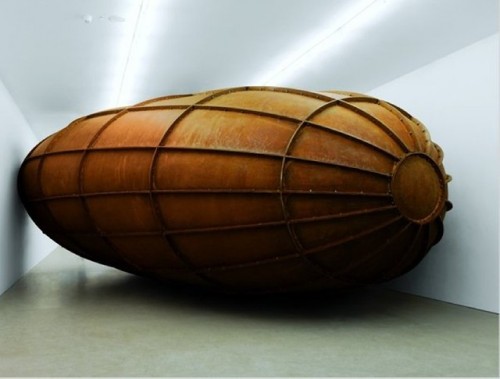Anish Kapoor at the Guggenheim
Memory of Eye Pod on View Through March 28
By: Charles Giuliano - Nov 16, 2009
The illustration of the site specific work by Anish Kapoor for "Memory" an enormous pod constructed of joined sections of contoured Cor-Ten steel is deceptive. This is not how we experience the piece which is on view at the Solomon R. Guggenheim Museum in New York City through March 28.For this photograph provided by the museum the image was created prior to having the work literally walled in.
To experience the piece we actually have to navigate our way around it. Catching glimpses from three vantage points. It is seemingly jammed into a confining space in a gallery that is approached as a side bar from the main spiral of the museum.
Approaching the gallery our entrance is restricted. Through a slit we see a part of the massive sculpture. It evokes our curiosity and compels us to find another vantage point. Working our way around we come in behind the work from the back of the gallery. Here again we have only a partial view.
We become intrigued with how precisely the sculpture has been set into and abuts the confines of the space. There is that sense of wonder about how it managed to get in there. Also the conundrum of why? What is the notion of creating such a large work and then hiding it from us?
With a combination of curiosity and frustration we find that there is a third approach. We enter a dark room. There is a guard hovering about which gives the experience some authority as well as restraint. Turning to the wall we encounter a gaping hole. Because of the low light level we can't see into it. But we know it is there. This evokes similar experiences created by the artist James Turrell. Just what is the depth of a void? Is it a flat plane or membrane and surface?
There is the urge to test the perception; to thrust a hand into the gaping darkness and measure its depth. Having approached it from the glimpses of the other views we know its massive dimension. So even though confronted by a perceptual mystery we have the "Memory" of the work that carries over from each limited glimpse.
The experience based on the visual and perceptual information is completed in our mind. We are challenged to connect the incidents of "Memory" and to make the work whole at least as a haunting thought.
With some restraint I shouted into the void wondering if there was an echo. Like a bat measuring its prey at night by sending out laser beams of sound that bounce back to its sensitive ears. Though blind it has that radar night vision. This action was taken with some concern for the reactions of other spectators and that hovering security guard. So it was a limited but seemingly significant response.
Having had the experience just what does it mean? That's always the tough part. Had we just encountered this large rusted steel pod would that be any different from visiting a ship yard, iron works, or encountering any number of huge pieces by Richard Serra? There would probably be a ho hum response. But it is the denial, in this case, that pokes us, as well as, the enormity, extravagance and outrageousness of the gesture. It speaks to the celebrity of the artist to create such an expensive work that is seemingly a kind of in joke and visual pun.
Bear in mind its specificity. It was made for this exact space and circumstance. It cannot be readily duplicated. Once it is disassembled it is then the parts of its whole assumed to be languishing in storage. Unless a museum or collector constructs or modifies a space the piece is just a "Memory." Evoked as "Do you remember that Kapoor installation at the Guggenheim?."
Oh well. Thanks for the memory.


